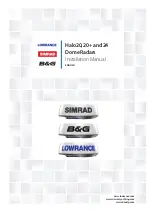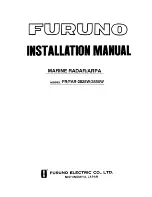
3.8 Location requirements
The optimum height for the Quantum
™
scanner is a location that is high enough above the waterline
to give a long range line-of-sight to the horizon, but not so high as to be adversely affected by the
vessel's pitching and rolling.
The scanner must also be mounted where it is:
• Above head height.
• Easily accessible.
• As near as possible to the vessel's centerline.
• On a rigid and stable platform, capable of securely supporting the scanner under seagoing
conditions.
• Clear of large objects such as the flybridge, large engine stacks, searchlights, horns, masts etc.
(see
for additional information).
• Clear of heat and fumes.
• At least 1 m (3 ft) from a magnetic compass or other scanners.
Shadow areas and false echoes
Mount the Radar scanner away from large structures or equipment, such as engine stacks,
searchlights, horns, or masts. These objects may cause shadow areas and false echoes. For
example, if you mount the Radar scanner on a mast, echoes from other targets may be reflected from
the mast. Wet sails may also cause shadow areas, so Radar performance may be reduced in the
rain. It is particularly important to avoid shadow areas near the bow. Raising or even lowering the
Radar scanner may help to reduce these effects.
In shadow areas beyond the obstruction there will be a reduction of the beam intensity. There may
be a blind sector if the beam intensity is not sufficient to obtain an echo from an object. This may
occur even at close range. For this reason the angular width and relative bearing of any shadow area
must be determined at installation.
You may be able to detect shadow areas or false echoes on your multifunction display. For example,
sea clutter can be used as a good indicator of blind arcs. Dark sectors on the Radar display indicate
possible shadowed areas. This information should be posted near the display unit and operators
must be alert for targets in these blind areas.
29
















































